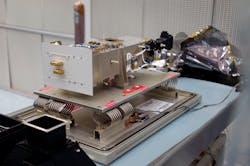SPECTROSCOPY: LAMP spectrometer finds helium in Moon’s atmosphere
Scientists at the Southwest Research Institute (Boulder, CO and San Antonio, TX), Johns Hopkins University (Baltimore, MD), and Central Arizona College (Coolidge, AZ) have used the Lyman Alpha Mapping Project (LAMP) spectrometer aboard NASA’s Lunar Reconnaissance Orbiter (LRO) to make the first spectroscopic observations of the noble gas helium (He) in the atmosphere surrounding the Moon. The remote-sensing observations complement in situ measurements taken in 1972 by the Lunar Atmosphere Composition Experiment (LACE) deployed by Apollo 17.
Although LAMP was designed to map the lunar surface, the team expanded its investigation to examine the far-ultraviolet emissions visible in the thin atmosphere above the lunar surface, detecting He over a campaign spanning more than 50 orbits. Because He also resides in the interplanetary background, several techniques were applied to remove signal contributions from the background He and determine the amount of He native to the Moon.
Detecting the hydrogen-alpha line
The LAMP spectrometer is tuned to detect the Lyman-alpha emission line of hydrogen at 121.6 nm. It has a first-order spectral passband of 575 to 196.5 nm, spectral resolution of 0.18 nm per spatial element, and spatial resolution of 0.29°. It has a mass of 6.1 kg, power consumption of 4.5 W, and dark-count rate of less than 20 counts/s. Because the Earth’s atmosphere absorbs the Lymanalpha line, any instrument designed to detect extraterrestrial emissions at that wavelength must be launched into space.
“The question now becomes, does the He originate from inside the moon, for example, due to radioactive decay in rocks, or from an exterior source, such as the solar wind?” says Alan Stern, LAMP principal investigator and associate VP of the Space Science and Engineering Division at Southwest Research Institute. “If we find the solar wind is responsible, that will teach us a lot about how the same process works in other airless bodies.”
If spacecraft observations show no such correlation, radioactive decay or other internal lunar processes could be producing He that diffuses from the interior or that is released during lunar quakes. Another point for future research involves He abundances. LACE measurements from the 1970s showed an increase in He abundances as the night progressed. This could be explained by atmospheric cooling, which concentrates atoms at lower altitudes. LAMP will further investigate how the abundances vary with latitude.
Another point for future research involves helium abundances. The LACE measurements from the 1970s showed an increase in helium abundances as the night progressed. This could be explained by atmospheric cooling, which concentrates atoms at lower altitudes. LAMP will further build on those measurements by investigating how the abundances vary with latitude.
During its campaign, LACE also detected the noble gas argon on the lunar surface. Although this line is significantly fainter and more difficult for the spectrograph to detect, LAMP also will seek argon and other gases during future observations. “These ground-breaking measurements were enabled by our flexible operations of LRO as a Science Mission, so that we can now understand the moon in ways that were not expected when LRO was launched in 2009,” says Richard Vondrak, LRO project scientist at NASA’s Goddard Space Flight Center.
LACE also detected the noble gas argon (Ar) on the lunar surface. Although this line is significantly fainter and more difficult for the spectrograph to detect, LAMP also will seek Ar and other gases during future observations.
REFERENCE
1. S.A. Stern et al., Geophys. Res. Lett., 39, 12 (2012); doi:10.1029/2012GL051797.

Gail Overton | Senior Editor (2004-2020)
Gail has more than 30 years of engineering, marketing, product management, and editorial experience in the photonics and optical communications industry. Before joining the staff at Laser Focus World in 2004, she held many product management and product marketing roles in the fiber-optics industry, most notably at Hughes (El Segundo, CA), GTE Labs (Waltham, MA), Corning (Corning, NY), Photon Kinetics (Beaverton, OR), and Newport Corporation (Irvine, CA). During her marketing career, Gail published articles in WDM Solutions and Sensors magazine and traveled internationally to conduct product and sales training. Gail received her BS degree in physics, with an emphasis in optics, from San Diego State University in San Diego, CA in May 1986.

John Wallace | Senior Technical Editor (1998-2022)
John Wallace was with Laser Focus World for nearly 25 years, retiring in late June 2022. He obtained a bachelor's degree in mechanical engineering and physics at Rutgers University and a master's in optical engineering at the University of Rochester. Before becoming an editor, John worked as an engineer at RCA, Exxon, Eastman Kodak, and GCA Corporation.
